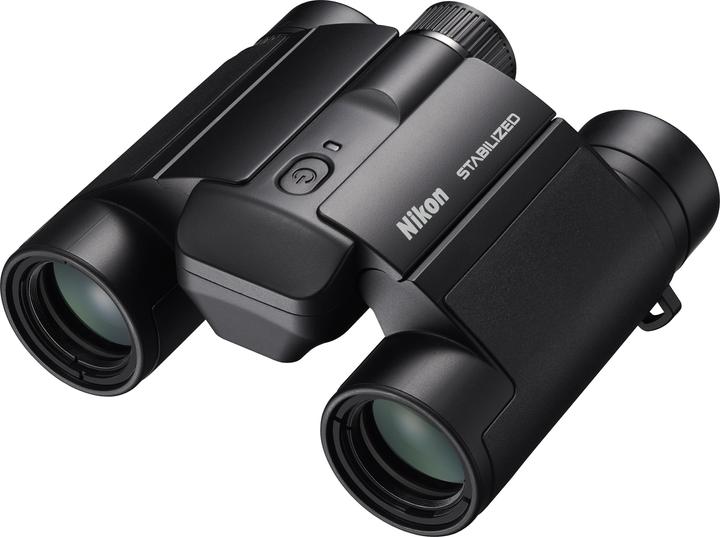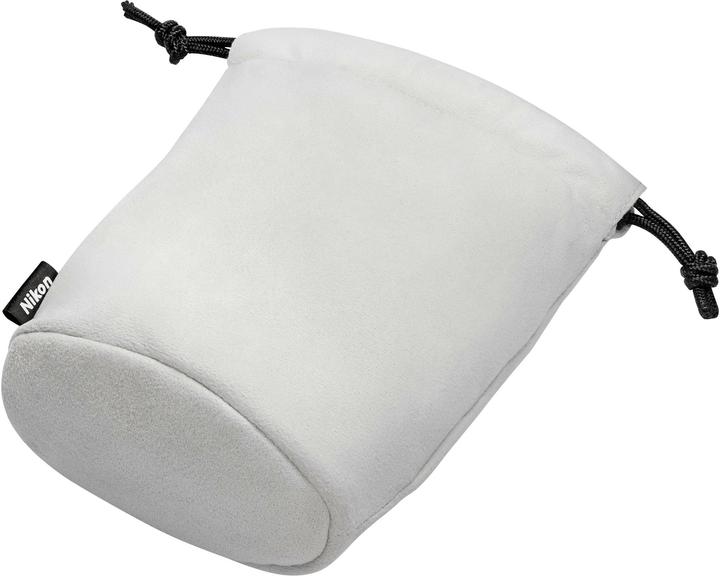

Nikon 12x25 S: The smallest stabilised binoculars tested
With the 12x25 S, Nikon is catering for a niche market. They are compact, magnify twelve times and are not easily shaken thanks to image stabilisation. Are the smallest stabilised binoculars a gimmick or a game changer?
A look through binoculars is always a small glimpse into your own future: everything becomes a little more shaky and wobbly. The more it enlarges, the more you realise that holding still is not that easy.
With a stabilised model, this changes at the touch of a button. These are usually massive devices with high magnification and a large aperture. Powerful models that bring distant targets closer and are not suitable as a constant leisure companion. Nikon now also offers compact all-rounders with stabilisation.
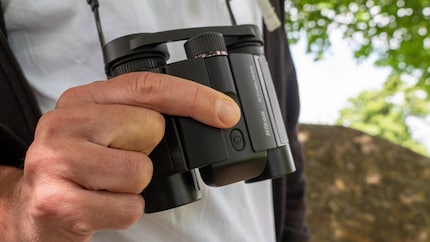
In addition to the 12x25 S discussed here, which was provided to me by the manufacturer for the test period, there is also the 10x25 S. It magnifies «only» tenfold.
Scope of delivery: I have to protect it myself
The story of the small box is quickly told: I find the usual operating instructions and instruction leaflets in various languages around the edge, with the 12x25 S enthroned in the centre. First impression: it has a decent weight for its compact dimensions.
I don't find this unpleasant. The impression increases somewhat after I discover the two AA batteries supplied and insert them into the compartment on the underside.

Then I double-check that I have threaded the delicate shoulder strap correctly. It has to hold, because otherwise this piece, which costs a good 600 francs, won't provide much protection. The eyepieces are covered by a flexible plastic cap, which I can also thread into the carrying strap.
This is useful so that the cover doesn't get left on the first available bench. This way, it dangles to the side of the strap when I use the binoculars.
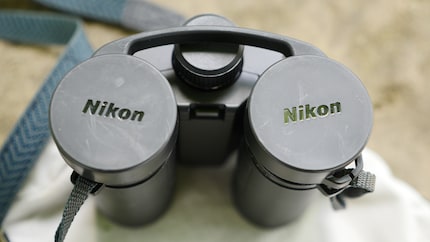
On the other side, the objective lenses remain uncovered. There is also a fluffy bag in the box in which the complete binoculars can be stowed and transported. Will the device survive drops? I doubt it.
And I wonder, because with my inexpensive Olympus 10x25 WP II or the Nikon Sportstar EX each come with at least a slightly more robust pouch with Velcro fastener. The light-coloured pouch offers protection against scratches and light impacts at best, and also magically attracts dirt.

An attempt at an explanation: The Nikon 12x25 S is in the price range of decent camera lenses. They usually only come with a bag. It is my job to protect this beautiful piece of technology accordingly. If I were to buy it, it would fit in my padded photo bag.
Puzzling: 12x25 4.5° = ?
You will have known or made a razor-sharp deduction that the «12x» stands for twelve times magnification. The 25 stands for the lens aperture - it is 25 millimetres. If you want to see well in the twilight, you need (among other things) a large lens aperture of 50 or more. However, the entire binoculars also grow with the aperture. The 25 is the right value for those who like it compact. A compromise in a practical trouser pocket size.

What you see also depends on the field of view. This is what the 4.5° stands for. It is easier to understand that the Nikon 12x25 S gives you a field of view of 79 metres from a distance of 1000 metres. A smaller range is not necessarily better. You first have to find what you want to look at - and be able to follow the object.
An area that is too large is also useless, as it can lead to blurring at the edges and you are focussing on one point anyway. I'm much more interested in the question: How good is the Nikon 12x25 S in everyday use? To find out, I've had it with me regularly over the past few weeks.
A sturdy leisure companion

I'm neither an ornithologist nor a planespotter, I just like to use binoculars in my spare time. In the countryside, on the sports field, in the airport runway, during the day and at dusk - and initially very curious to see what the stabilisation of the Nikon 12x25 S could do.
It can be activated at the touch of a button, followed by a «Clack!» sound. This reminds me that something is happening here mechanically. It's not an electronic viewfinder image that is being stabilised. Sensors register my hand movements and optically compensate for them so that a smoother image arrives at the eyepiece. Nikon illustrates the principle in an image simulation like this.
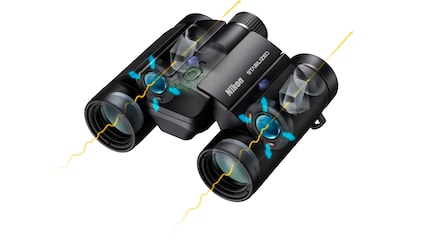
Source: Nikon
In practice, the wow effect is immediately noticeable. As soon as I switch on the function, the image before my eyes calms down. The bird on the branch sways only slightly with the wind. Panning is just as smooth as the A380 taking off in the left-hand bend. Even when I make jerky movements to follow the action on the football pitch, the stabilisation takes it in its stride.
On very rare occasions during the test period, I had the feeling that the image hung and jumped for a millisecond - but I was never able to consciously reproduce this. Although the 12x25 S can also be used unstabilised as «normal» binoculars, briefly pressing the power button quickly becomes routine. Without, I can only decipher the writing on the construction crane in the city with difficulty. With, you could almost read a book at the same distance.
In terms of field of view and sharpness, I'm also happy with the little Nikon. Even at dusk, the stabilised dwarf still produces a decent image at the beginning - even in a somewhat unfair duel in which I mainly want to compare the stabilisation.
Not better, but significantly longer
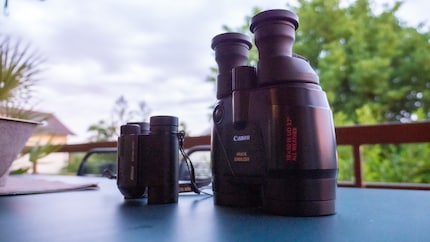
I meet up in the evening with a colleague who brings along the Canon 18x50 IS. We alternately tested whether we noticed any differences between the two models in terms of stabilisation. With Canon, it perhaps takes a little longer for the image to stabilise. Otherwise, we can only conclude that the function is a real added value in both cases. At 18x magnification, it is of course even more important.
The field of view at 1000 metres doesn't seem all that different. As a reminder: with the Nikon 12x25 S I can see 79 metres at this distance, with the 18x50 IS it's 65. As soon as it gets darker, the Canon shows its optical advantages. However, at 1.2 kilograms, it is so heavy that it doesn't fit in my pocket on every outing.
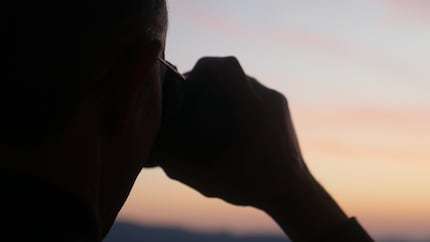
This bag also contains some spare batteries, which my colleague will soon have to reach for. Depending on the temperature, they last up to two and a half hours on the big Canon. The Nikon 12x25 S should last around twelve hours. Practical: if I forget to switch it off, the device switches itself off automatically after «about an hour». I try it out - and after exactly 60 minutes the light goes out. The Canon model can't do that either. If it were up to me, the switch-off function would make sense after just 15 minutes.
Advantages and disadvantages in everyday life
My other comparison model is the cheaper (unstabilised) Olympus 10x25 WP II. At first glance, it has two advantages: It is waterproof, whereas the Nikon 12x25 S is only protected against splash water. And it is significantly more compact.
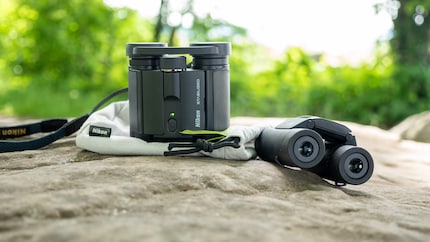
The eyecups are made of hard plastic and can be unscrewed slightly to adjust the distance between the lens and the eye. I don't like using either with glasses. They narrow the field of vision. There is a dioptre equaliser on the right. So you focus on the left eye first and then correct the right eye. I find the large focussing ring on the Nikon more pleasant, otherwise the price difference is not so strongly reflected in the feel.
Although the devices are small enough to fit comfortably in the hand, I would have liked a more non-slip rubber coating on the Nikon. This is more of a suggestion than a realisation at the points where the fingers hold the binoculars. That may be a matter of taste.
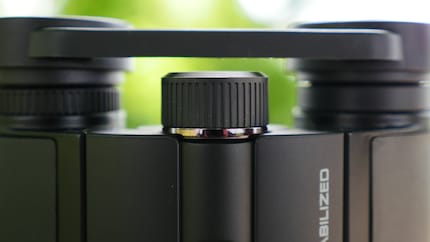
One thing I notice again and again in practice, however: even at ten times magnification, it can be difficult to keep a steady hand if the observation target is a little further away. This is less of an issue if you are standing stably and can support yourself. And a little more if you are out of breath on a hike, sitting in a car or observing animals in the wild.
But it becomes more noticeable the more I get used to Nikon's magic button, which switches off the shake. It makes me watch longer and better. It feels like you're riding onto a freshly tarmaced road after a bike ride over cobblestones. Really a great feature.
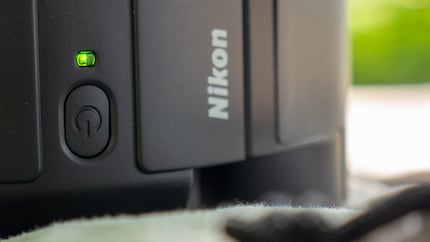
The biggest disadvantage for me after this test: I will no longer be able to look through my cheap binoculars without getting a shaky hand - because I will miss the image stabilisation very much.
In a nutshell
A steady hand at the touch of a button - stabilisation is top notch
There are things that I get used to very quickly. Stabilised binoculars fall into this category. At the touch of a button, the shaky image stabilises at twelve times magnification. This makes for relaxed observation. Two AA batteries provide about twelve stable hours of use, and the automatic switch-off after 60 minutes protects against unpleasant surprises.
The binoculars are compact enough to be a regular leisure companion: In nature, at sporting events or at concerts. Wherever there is already a lot of movement, the stabilisation is particularly useful. The device itself should not be exposed to too much action and should be protected from water, dust or hard knocks. It feels high-quality and looks appealing, but for my taste it could be a bit more grippy.
For me, the price is justified by the fact that I use it much longer than unstabilised binoculars. It is simply much more fun and the function is unique in this compact all-rounder class.
Pro
- Great stabilisation
- Two AA batteries last 12 hours
- Automatic switch-off
- Good optics
Contra
- No sturdy case
- relatively smooth/slippery
Simple writer and dad of two who likes to be on the move, wading through everyday family life. Juggling several balls, I'll occasionally drop one. It could be a ball, or a remark. Or both.
